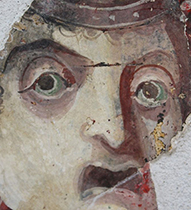 1>
1>Type III - "...the far side of the empty court is visible."
Little's 'type III tragic stage sets' are defined by "...the far side of the empty court is visible." (Little 1936 : 411). He exemplifies this by referring to a wall-painting in the summer triclinium of Villa P. Fannius Synistor. Unfortunately Little does not explain why we should associate an empty court with tragic stage sets. The presence of masks above the left and right parapets does not necessarily identify this composition as a stage set because generic personae were often depicted in mask form and their presence is ubiquitous throughout all the phases of Romano-Campanian wall-painting (fig.1). Once again this facade stands as an entrance to a space that appears sacrosanct. The closed gate with its serrated top and the black curtains just visible above the parapets reinforces this theme. The tholos, seemingly floating above the central pediment, also gives the composition a sense of irreality, as does the centrally placed urn framed by a commemorative garland. Similar depictions of floating tholoi can be seen on the lateral walls in the triclinium of Villa di Poppae.
Little's type III agenda is better exemplified by a painting that was discovered after the publication of Scaenographia. It is perhaps the clearest example of "...the far side of the empty court is visible." The divinity honoured within this space is Apollo, symbolised by the oracular tripod with Apollonian torch and bucrania at its base. The clipeate imagines (ancestor shields) situated high up on either side of the propylaeum or entrance facade and the demonic mask and peacock all confirm the sense that we are looking into a sanctuary into which few may enter.
The depiction of a sanctuary within a room is echoed fourfold in the 'room of the masks' in the Casa di Augusto on the Palatine hill in Rome. All four walls depict architectural facades akin to those associated with Roman temporary theatres (fig.2). Set into each facade of 'the room of the masks' is a naiskos or aedicula leading to sanctuary in which can be seen objects associated with commemoration or worship. Both of these framing devices are architectural features designed to highlight the sanctity of the object that is seen or placed within them. They appear on numerous Greek vases and are a common feature in Romano-Campanian wall-painting (fig.3&4). The demonic masks on either side of the central openings in the 'room of the masks' may well perform an apotropaic function as opposed to that which is associated with theatrical personae.
|